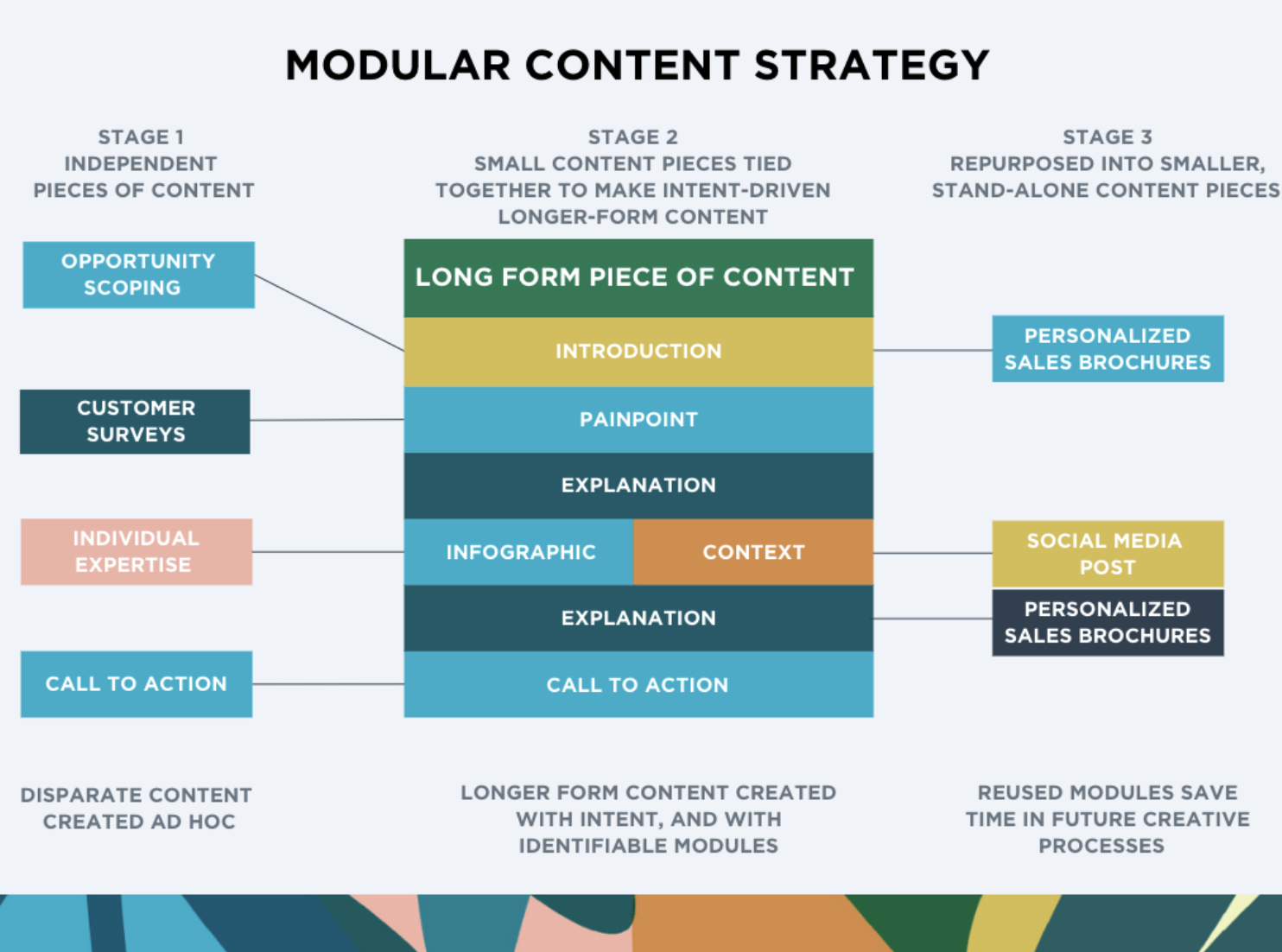As the digital world continues to expand, content creators search for methods that allow them to efficiently engage with their audiences. Modular content emerges as a practical solution that not only streamlines the content creation process but can also foster customer and audience trust.
Let's take a closer look at modular content and its potential to enhance the trustworthiness of brand marketing efforts.
Understanding Modular Content
At its essence, modular content involves breaking content down into reusable, interchangeable segments. Picture it as building blocks for digital content.
For instance, a company might produce a detailed white paper on a particular subject. This foundational content can then be segmented into smaller modules: individual facts, infographics, testimonials, or summaries. These bite-sized chunks can find life across varied platforms and formats, from social media teasers to newsletters and podcasts.

Image source: Turtl
Imagine you've crafted a detailed article about sustainable living practices and it's now prominently featured on your site. While this elaborate piece is ideal for eco-enthusiasts wanting a complete perspective, it might seem dense to those on the lookout for a swift takeaway.
This is where modular content shines. With this method, you can split the article into more manageable segments, like 'The Basics of Sustainable Living,' 'Making Recycling a Daily Habit,' and 'Green Choices in Daily Life.'
These refined segments can then be adjusted to suit varied audience interests. For instance, if a reader is particularly curious about transitioning into an eco-friendly routine, you might introduce them to the 'Making Recycling a Daily Habit' section. Serving content in this precise manner not only meets specific user interests but also deepens their engagement with your brand, fostering long-term loyalty.
Additionally, when you're planning to draft posts for social media channels about green living, these concise sections come in handy. They're ideal for short updates or as highlighted points in larger outreach efforts.
Benefits of Modular Content
-
Efficiency: One of the immediate benefits of modular content is the efficiency it brings to the table. By creating content that can be repurposed across various channels, brands can ensure a consistent presence without the need to generate new content from scratch continually.
-
Cost-effective: From a business standpoint, modular content is cost-effective. Brands can invest in creating high-quality foundational pieces and then reuse them in multiple ways, maximizing their ROI on content creation.
-
Flexibility: Modular content can easily be adapted, updated, and reshuffled based on changing market trends, news, or feedback, giving brands a chance to remain agile and relevant.
How Modular Content Can Enhance Audience Trust
-
Consistency: Reusing content modules means brands can ensure uniform messaging across diverse platforms. Brand consistency a cornerstone of trust; when audiences receive a consistent message, they're more likely to view the source as dependable.
-
Relevance: By adjusting content for specific platforms while maintaining the core message, brands can ensure the content remains pertinent to the audience's context, adding value and trustworthiness.
-
Timely Updates: Modular content's structure makes it easier to update specific parts without redoing an entire piece. This efficiency ensures audiences receive current and timely information.
-
Personalization: With growing demands for personalized content, modular content can be a game-changer. Brands can adjust modules to cater to different audience segments, demonstrating attentiveness to diverse audience needs.
Building Trust in a Crowded Digital Landscape
With the sheer volume of content available, establishing trust is more critical than ever for brands. Here's how modular content can play a role:
-
Transparency and Authenticity: The segmented nature of modular content allows brands to clearly credit sources and data, bolstering their authenticity.
-
Quality Over Quantity: By reusing high-quality pieces, brands can position themselves as credible information hubs rather than churning out endless content with diluted value.
-
Engagement: Encouraging interaction is another strength of modular content. It could be a deeper dive into a specific topic, exploring an infographic series, or participating in a related webinar. Such interactive elements can help create a lasting connection with audiences.
-
Feedback Loop: Modular content's adaptability also means brands can quickly respond to audience feedback. If a particular module doesn't resonate, it can be tweaked or replaced without affecting the entire content piece, showing audiences that their feedback is valued.
Conclusion
Modular content offers a balanced approach for brands seeking to navigate the complexities of the digital world. It emphasizes key elements like consistency, relevance, and personalization, positioning brands to build and maintain audience trust.
As the digital content landscape keeps evolving, embracing techniques like modular content can be a valuable strategy for brands aiming for longevity and meaningful audience relationships.
Leave a Comment